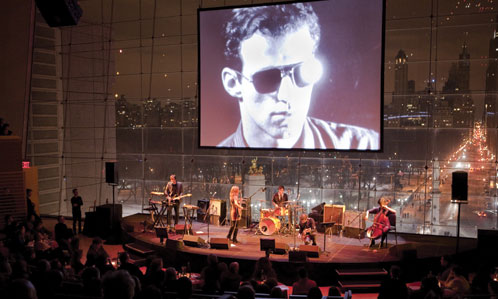 Spring 2009
Spring 2009|
Dean and Britta perform the soundtrack at New York City’s Lincoln Center. Juan Arredondo/The new york times/redux
Just like Dennis Hopper himself, the song that accompanies Andy Warhol’s Screen Test of the actor—already famous by the time of this mid-1960s film portrait—is a host of subtle juxtapositions. It’s appealing and churlish; full of both subtlety and bravado; handsome yet wicked. When Hopper’s lips curl into a half-smile, it might be just another understated moment in what amounts to a four-minute-long, slow-motion photograph. But as the music simultaneously reaches its crescendo, the image of a young Hopper becomes a fully realized story—a crash of pop-culture history that blurs the boy-next-door portrait with our knowledge of Hopper’s work to come. In other words, the dark instrumental, titled Herringbone Tweed, works perfectly for 13 Most Beautiful… Songs for Andy Warhol’s Screen Tests, a performance that combines 13 of Warhol’s film portraits with music by New York City duo Dean Wareham and Britta Phillips, co-commissioned by The Andy Warhol Museum and The Pittsburgh Cultural Trust for the 2008 Pittsburgh International Festival of Firsts. Since the performance’s debut last fall, it’s been touring nationally and has become a sought-after DVD release, further elevating The Warhol’s stature within an exclusive club of American contemporary art and performance centers. During the project’s coming-out party last October at Pittsburgh’s Byham Theater, Ben Harrison, The Warhol’s associate curator for performance, beamed parentally—and with good reason. Harrison, along with Geralyn Huxley, the museum’s curator of film and video, came up with the idea years ago. They wrestled with possible songwriters, eventually deciding on Dean and Britta—formerly of iconic indie group Luna—partially for their lush pop compositions, partially for their stylistic and artistic references to the downtown New York scene of Andy Warhol’s Factory. “A big part of what we do is interpreting our collection and re-contextualizing it,” says Harrison. “It’s about showing Warhol’s unwavering relevancy. 13 Most Beautiful is about portraiture—trying to capture the essence of a person, with the music pulling out another nuance that you might not have otherwise felt.” Already the critically lauded combination has toured New York City’s Lincoln Center and multiple venues on the West Coast, with negotiations for international stops ongoing. February’s release of the 13 Most Beautiful DVD by international video distributors Plexifilm, however, was an even bolder step for The Warhol. Presented with a booklet of essays by Harrison, Huxley, and others, as well as biographies of all 13 Screen Test subjects, it’s a momentous step for the museum as a creator of new consumable artwork and it releases Warhol’s films into the commercial market. Responsible stewardship of Warhol’s work is an important part of The Warhol’s mission, and handing Warhol’s Screen Tests over to Dean and Britta was not a decision made lightly. “This is the first major release of early Warhol films on DVD,” says Harrison. “Warhol pulled his films from distribution in the mid-1970s. So since then, unless you’ve gone to a museum or gallery where they’ve been presented, you haven’t seen them. That was a big part of our hesitancy: What is the impact on the value of the Screen Tests? We release these on DVD, and they’re out in the market—they’ll be online, on YouTube. We came to the conclusion that, yes, we’re willing to take that risk. We’re well into the 21st century, and Warhol would’ve embraced all things Internet. Screen Tests were a perfect first step.” The impact of the tours and DVD on the institution itself could be substantial, according to Charles Helm, Harrison’s counterpart at Columbus, Ohio’s Wexner Center for the Arts, to whom Harrison has turned for advice throughout the process. “Having a project like this out in the world advances the institution’s standing in the field,” says Helm, the Wexner’s director of performing arts. “As you accrue a few of these that carry your credit out into the world, it changes your perception with audiences, funders, everyone in the field. “13 Most Beautiful has already generated substantial interest. And with it, The Warhol goes from being a well-respected institution with a performing arts program on the national and international radar to a proactive organization, generating new projects that other people want, which brings you into a circle with other like-minded institutions.” |
Carnegie Museums After Dark · Art Without Walls · Recollecting Andrey Avinoff · Look… to see, to remember, to enjoy · President's Note · NewsWorthy · Now Showing · Face Time: Kim Amey · About Town: Art in Bloom · Field Trip: Year of Restoration · Science & Nature: Scientists Among Us · Artistic License: Bosom Buddies · Then & Now: Earth Day
 |
Copyright © 2017 CARNEGIE Magazine. All rights reserved. |

